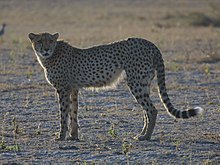Acinonyx
| Acinonyx | |
|---|---|
 | |
| Cheetah (Acinonyx jubatus) | |
| Scientific classification | |
| Domain: | Eukaryota |
| Kingdom: | Animalia |
| Phylum: | Chordata |
| Class: | Mammalia |
| Order: | Carnivora |
| Suborder: | Feliformia |
| Family: | Felidae |
| Subfamily: | Felinae |
| Genus: | Acinonyx Brookes, 1828 |
| Species | |
| Synonyms | |
| |
Acinonyx is a genus within the Felidae family.[1] The only living species of the genus, the cheetah (A. jubatus), lives in open grasslands of Africa and Asia.[2]
Several fossil remains of cheetah-like cats were excavated that date to the late Pliocene and Middle Pleistocene.[3] These cats occurred in Africa, parts of Europe and Asia about 10,000 years ago. Several similar species classified in the genus Miracinonyx lived in North America at the same time; these may have been more closely related to the genus Puma.[2]
Taxonomy
[edit]Acinonyx was proposed by Joshua Brookes in 1828.[4]
Between the late 18th century and the early 20th century, the following Acinonyx species and subspecies were described:[1]
- Felis jubatus by Johann Christian Daniel von Schreber in 1777 was based on earlier descriptions by Comte de Buffon and Thomas Pennant.[5]
- Felis venatica by Griffith in 1821 was based on a sketch of a cheetah from India.[6]
- Cynailurus soemmeringi by Fitzinger in 1855 was a live male cheetah brought by Theodor von Heuglin to Tiergarten Schönbrunn from Kordofan in southern Sudan.[7]
- Acinonyx hecki by Hilzheimer in 1913 was a captive cheetah from Senegal in the Berlin Zoological Garden, named in honour of the zoo's director.[8]
In 1993, Acinonyx was placed in the monophyletic subfamily Acinonychinae. Molecular phylogenetic analysis has shown that it is the sister group of the genus Puma, and it is now placed within the subfamily Felinae.[1]
In addition, the following fossil Acinonyx species were described:
- Acinonyx pardinensis by Croizet et Jobert in 1828[9]
- Acinonyx arvernensis by Croizet et Jobert in 1828[9]
- Acinonyx intermedius by Thenius in 1954[10]
- Acinonyx aicha by Geraads in 1997[11]
- Acinonyx pleistocaenicus by Zdansky in 1925[12]
The "Linxia Cheetah" ("A. kurteni") was initially described by Christiansen and Mazák in 2009 on the basis of a skull from Pliocene strata in China, and touted as the most primitive member of the genus.[13] In 2012, "A. kurteni" was invalidated as a species when the holotype was determined to be a forgery composed of Miocene-aged fragments.[14][15]
See also
[edit]- American cheetahs of the related genus Miracinonyx
References
[edit]- ^ a b c Wozencraft, W. C. (2005). "Genus Acinonyx". In Wilson, D. E.; Reeder, D. M. (eds.). Mammal Species of the World: A Taxonomic and Geographic Reference (3rd ed.). Johns Hopkins University Press. pp. 532–533. ISBN 978-0-8018-8221-0. OCLC 62265494.
- ^ a b Krausman, P. R. & Morales, S. M. (2005). "Acinonyx jubatus" (PDF). Mammalian Species (771): 1–6. doi:10.1644/1545-1410(2005)771[0001:aj]2.0.co;2. S2CID 198969000. Archived from the original (PDF) on 3 July 2015. Retrieved 2 July 2015.
- ^ Hemmer, H.; Kahlke, R.-D.; Keller, T. (2008). "Cheetahs in the Middle Pleistocene of Europe: Acinonyx pardinensis (sensu lato) intermedius (Thenius, 1954) from the Mosbach Sands (Wiesbaden, Hessen, Germany)". Neues Jahrbuch für Geologie und Paläontologie, Abhandlungen. 249 (3): 345–356. doi:10.1127/0077-7749/2008/0249-0345.
- ^ Brookes, J. (1828). "Section Carnivora". A catalogue of the Anatomical and Zoological Museum of Joshua Brookes. London: Richard Taylor. p. 16.
- ^ Schreber, J. C. D. (1777). "Der Gepard". Die Säugthiere in Abbildungen nach der Natur mit Beschreibungen (Dritter Theil). Erlangen: Wolfgang Walther. pp. 392–393.
- ^ Griffith, E. (1821). "Felis venatica". General and particular descriptions of the vertebrated animals, arranged conformably to the modern discoveries and improvements in zoology. Order Carnivora. London: Baldwin, Cradock and Joy.
- ^ Fitzinger, L. (1855). "Bericht an die kaiserliche Akademie der Wissenchaften über die von dem Herrn Consultatsverweser Dr. Theodor v. Heuglin für die kaiserliche Menagerie zu Schönbrunn mitgebrachten lebenden Thiere". Sitzungsberichte der Kaiserlichen Akademie der Wissenschaften. Mathematisch-Naturwissenschaftliche Classe. 17: 242–253.
- ^ Hilzheimer, M. (1913). "Über neue Gepparden nebst Bemerkungen über die Nomenklatur dieser Tiere". Sitzungsberichte der Gesellschaft Naturforschender Freunde zu Berlin (5): 283–292.
- ^ a b Croizet, J. B.; Jobert, A. C. G. (1862). Recherches sur les ossemens fossiles du département du Puy-de-Dôme. Paris: Chez les principaux libraires.
- ^ Thenius, E. (1954). "Gepardreste aus dem Altquartär von Hundsheim in Niederösterreich". Neues Jahrbuch für Geologie und Paläontologie, Monatshefte: 225–238.
- ^ Geraads, D. (1997). "Carnivores du Pliocène terminalde Ahl al Oughlam (Casablanca, Maroc)". Geobios. 30 (1): 127–164. Bibcode:1997Geobi..30..127G. doi:10.1016/s0016-6995(97)80263-x.
- ^ Jiangzuo, Q.; Wang, Y.; Madurell-Malapeira, J.; Bartolini Lucenti, S.; Li, S.; Wang, S.; Li, Z.; Yang, R.; Jia, Y.; Zhang, L.; Chen, S.; Jin, C.; Wang, Y.; Liu, J. (2024). "Massive early Middle Pleistocene cheetah from eastern Asia shed light onto the evolution of Acinonyx in Eurasia". Quaternary Science Reviews. 332. 108661. Bibcode:2024QSRv..33208661J. doi:10.1016/j.quascirev.2024.108661.
- ^ Christiansen, P.; Mazák, J. H. (2009). "A primitive Late Pliocene cheetah, and evolution of the cheetah lineage". Proceedings of the National Academy of Sciences. 106 (2): 512–515. Bibcode:2009PNAS..106..512C. doi:10.1073/pnas.0810435106. PMC 2626734. PMID 19114651. (Retracted, see doi:10.1073/pnas.1211510109, PMID 22908293, Retraction Watch)
- ^ Knevitt, O. (2011). "Five Greatest Palaeontology Fakes Of All Time #5: The Linxia Cheetah". Science 2.0. Retrieved 13 January 2013.
- ^ Mazák, J. H. (2012). "Retraction for Christiansen and Mazák. A primitive Late Pliocene cheetah, and evolution of the cheetah lineage". Proceedings of the National Academy of Sciences of the United States of America. 109 (37): 15072. Bibcode:2012PNAS..10915072.. doi:10.1073/pnas.1211510109. PMC 3443189. PMID 22908293.
External links
[edit] Media related to Acinonyx at Wikimedia Commons
Media related to Acinonyx at Wikimedia Commons Data related to Acinonyx at Wikispecies
Data related to Acinonyx at Wikispecies- "Acinonyx" at the Encyclopedia of Life


 French
French Deutsch
Deutsch